United Kingdom Telecom Towers Market Size
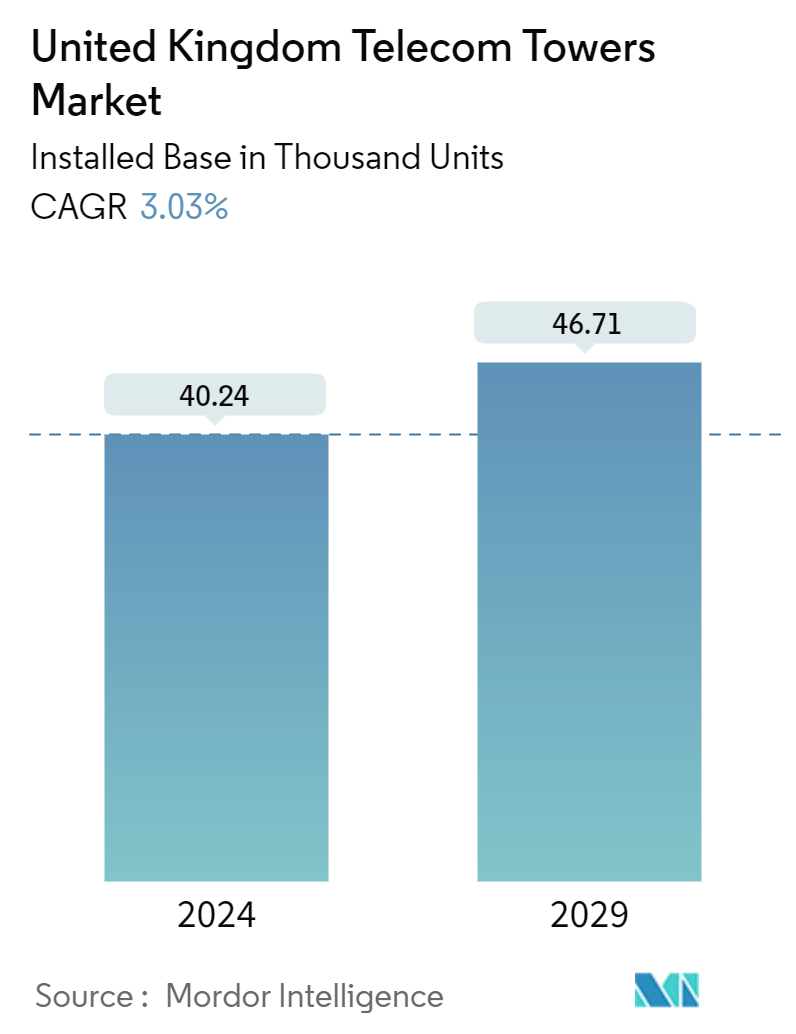
| Study Period | 2019 - 2029 |
| Base Year For Estimation | 2023 |
| Forecast Data Period | 2024 - 2029 |
| Historical Data Period | 2019 - 2022 |
| CAGR (2024 - 2029) | 3.03 % |
| Market Concentration | Medium |
Major Players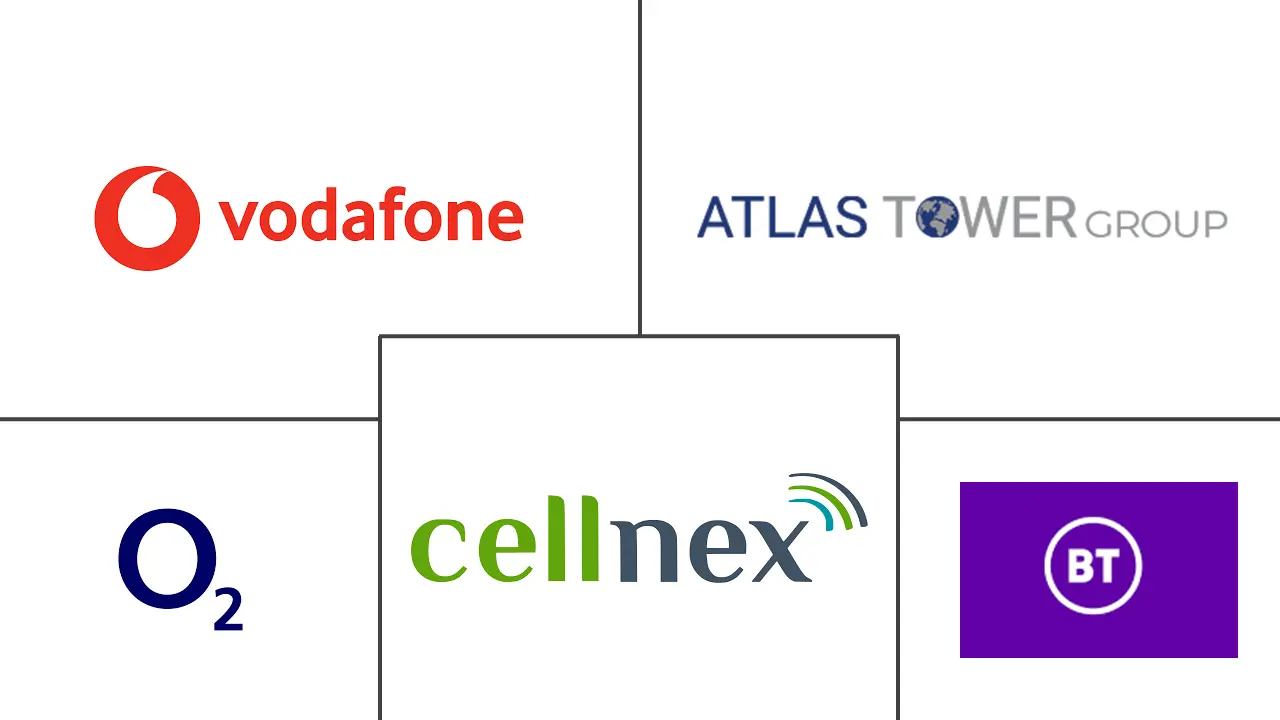
*Disclaimer: Major Players sorted in no particular order |
United Kingdom Telecom Towers Market Analysis
The United Kingdom Telecom Towers Market size in terms of installed base is expected to grow from 40.24 Thousand units in 2024 to 46.71 Thousand units by 2029, at a CAGR of 3.03% during the forecast period (2024-2029).
- The UK telecom towers market is expanding, primarily due to the 5G rollout, which necessitates additional towers for improved coverage and capacity. Rising data consumption from smartphones and connected devices is further propelling this demand. The government's push for rural connectivity is also bolstering infrastructure in underserved areas.
- The trend of network sharing among telecom operators reduces costs and heightens the demand for neutral host towers. The growing adoption of IoT and smart city initiatives is also amplifying the need for more telecom towers to support these advancements. The growing collaboration and widespread deployment of 5G technology, rising data consumption, and the growing adoption of key technologies like AI and ML are projected to drive substantial growth in the telecom towers market in the United Kingdom during the forecast period.
- Notable strides in 5G and 6G services are evident nationwide, bolstered by the government's backing through supportive legislation and investments. To bridge the connectivity divides across the country, federal authorities are collaborating with telecom carriers to ensure a more reliable cellular service. These dynamics are set to drive the UK telecom towers market during the forecast period.
- In February 2024, the Department for Science, Innovation and Technology announced a significant investment of GBP 62 million (USD 79.07 million), positioning the United Kingdom at the forefront of shaping the next generation of telecom networks. This funding, part of the UK Research and Innovation's (UKRI) GBP 70 million (USD 89.28 million) Technology Missions Fund (TMF) Future Telecoms Mission, aims to bolster the development of pivotal technologies, including 6G, for future telecom networks.
- In August 2023, Vodafone commenced the installation of OpenRAN equipment at 2,500 sites in Wales and the southwest of England. Beginning in Devon, the company started replacing outdated Huawei technology with OpenRAN technology at these mobile sites. Vodafone aims to execute a multi-year phased delivery, ensuring the removal of all high-risk vendor (HRV) technology from the radio access network (RAN) in accordance with government timelines.
- However, factors like environmental concerns, high infrastructure deployment costs, and community resistance to new tower installations are hindering the telecom towers market in the country. Additionally, as the market matures and mobile coverage reaches saturation, the demand for new towers may decrease, further constraining growth prospects.
United Kingdom Telecom Towers Market Trends
5G Deployment Acts as a Major Catalyst for Growth in the Cell-tower Leasing Environment
- In the UK telecom towers market, the rapid expansion of 5G deployments is propelling growth in the cell-tower leasing industry. The rollout of 5G technology requires a denser network of cell sites compared to its predecessor, 4G, owing to the former’s higher frequency bands, which cover shorter distances and face easier obstructions. This factor drives a significant need for bolstering infrastructure, necessitating the construction of new towers and upgrades to the existing ones.
- To meet rising demands, mobile network operators (MNOs) are turning to independent tower companies for leasing agreements, moving away from the traditional model of building and managing their own sites. MNOs can swiftly expand their 5G networks by opting for leases, sidestepping significant upfront costs. Simultaneously, tower companies benefit from increased occupancy rates and longer contract durations. This mutually beneficial management is driving the expansion of the cell-tower leasing landscape.
- As 5G continues to roll out, MNOs are upgrading their sites with 5G-compatible equipment, leading to a heightened demand for leased tower space. The UK telecom towers market is increasingly turning to leasing to achieve widespread 5G coverage, particularly in urban and suburban areas, highlighting the significance of both existing and new towers.
- In May 2024, VMO2 and Accenture teamed up to pursue the private 5G market in the United Kingdom, initially focusing on construction, transportation and logistics, manufacturing, utilities, warehousing, and sports venues. The solutions leverage Accenture's Edge Orchestration Platform and will seamlessly integrate edge computing, data analytics, AI, and embedded cybersecurity.
- In September 2023, the UK government allocated GBP 88 million (USD 109 million) to 19 projects, showcasing the promise of open radio access networks (OpenRAN) in enhancing mobile services. The government's Department for Science, Innovation and Technology (DSIT) also announced that sporting venues and popular tourist destinations nationwide will pilot new mobile technologies backed by OpenRAN networks.
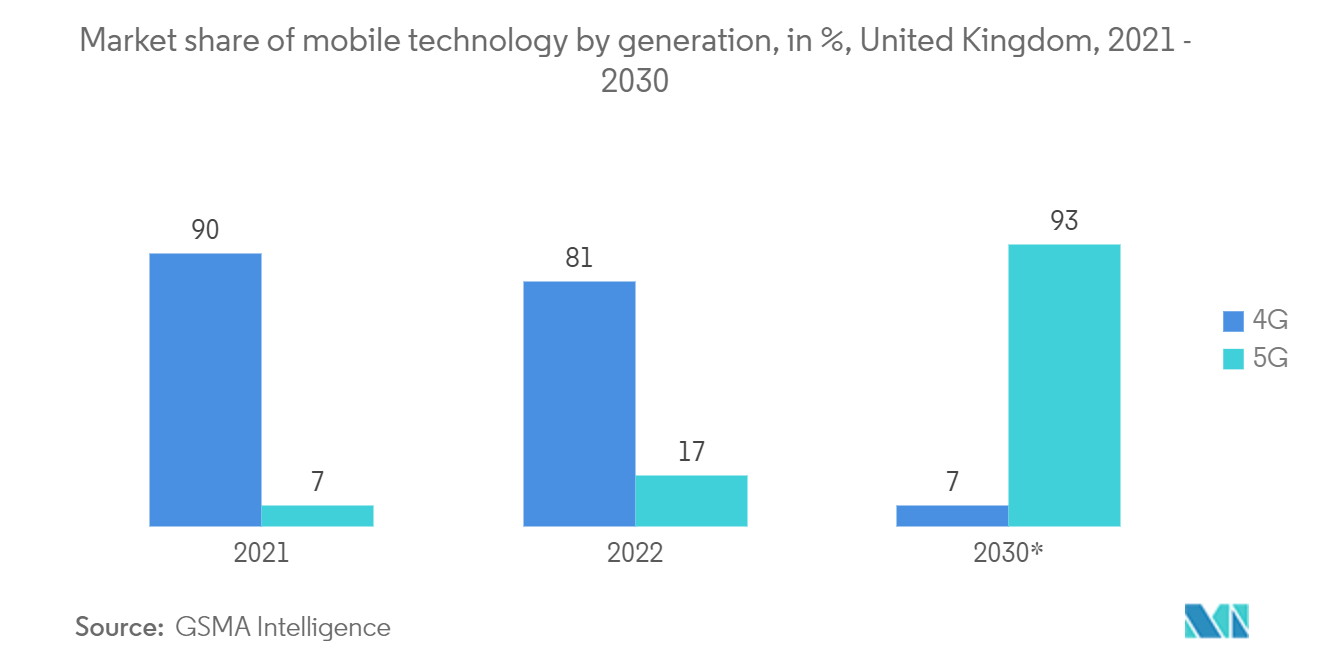
The Rooftop Segment is Expected to Witness Significant Growth Opportunities
- The telecom towers market in the United Kingdom is witnessing robust growth, primarily driven by an increasing demand for rooftop installations. Due to challenges such as land constraints and community pushback against new ground-based tower constructions, rooftop installations have emerged as a compelling alternative. These installations enable mobile network operators (MNOs) to enhance network coverage and capacity while avoiding the lengthy approval processes of constructing new towers.
- Rooftop sites, strategically located in urban areas, allow MNOs to address the rising demand for high-speed data and improve connectivity, particularly in crowded regions. This need intensifies as the United Kingdom speeds up its 5G rollout, requiring a denser network of sites to ensure optimal coverage and performance. According to Ofcom, as of the end of Q4 2023, the United Kingdom had 4.82 million mobile broadband subscribers.
- Additionally, communities and local governments view rooftop installations as less intrusive, making them more acceptable. For MNOs, these installations offer a cost-effective advantage by utilizing pre-existing structures. This approach reduces capital expenditure and hastens the activation timeline for sites.
- The growing demand for rooftop installations is propelling the UK telecom towers market. These rooftop solutions provide scalability and also adeptly navigate the regulatory, environmental, and community hurdles associated with traditional tower construction.
- In March 2024, in a landmark deal poised to transform the Irish telecommunications landscape, Phoenix Tower International, a player in wireless communication infrastructure ownership and operations, signed an agreement to purchase Cellnex's Irish division. Cellnex's Irish division, previously recognized as Cignal Infrastructure, stands out as a key player in Ireland's telecommunications infrastructure landscape. The company boasts a substantial portfolio, encompassing around 1,500 tower sites, rooftop installations, and urban telecommunications assets, predominantly catering to the nation's leading MNOs.
- In November 2023, GLIL Infrastructure committed approximately GBP 360 million (USD 475.36 million) to acquire a minority stake in Cornerstone Telecommunications Infrastructure, recognized as a significant mobile towers entity in the United Kingdom. Virgin Media O2 has confirmed the sale of a 16.67% minority stake in its mobile tower joint venture, Cornerstone, to the United Kingdom-based infrastructure fund.
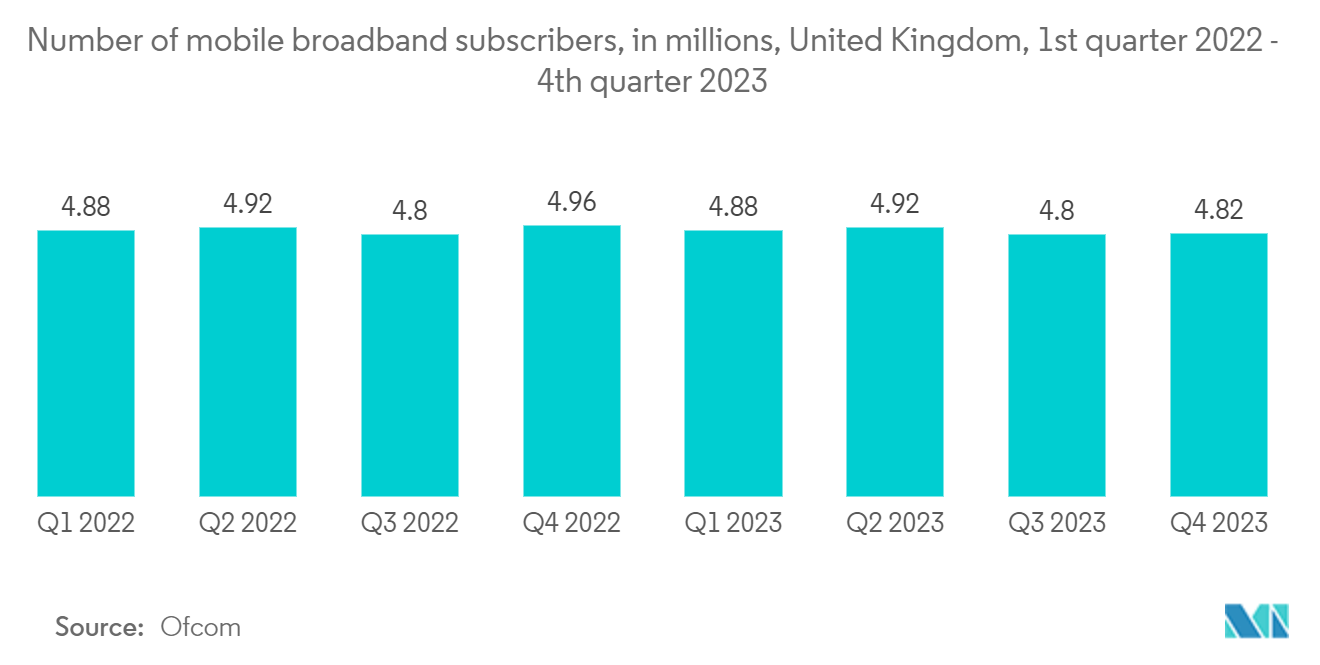
United Kingdom Telecom Towers Industry Overview
The UK telecom towers market is moderately consolidated and consists of several major players. The major market players with a prominent share in the market, such as BT Group, Vodafone UK, and Atlas Tower Group, are working on expanding their customer base through the adoption of various technologies.
- July 2024: Virgin Media O2 and Vodafone UK renewed and upgraded their decade-long mobile network sharing agreement, strengthening nationwide mobile coverage and enhancing customer services. This strategic partnership stands as a pivotal moment in the United Kingdom's telecommunications domain, poised to revolutionize the experience for millions of customers nationwide.
- March 2024: Phoenix Tower International (PTI) finalized a definitive agreement with Cellnex Telecom, securing a 100% acquisition of Cellnex's operations in Ireland. This move will bolster PTI's presence in Ireland, integrating 1,700 mobile telecom sites and nearly 200 land locations hosting third-party wireless services. Phoenix Tower International's acquisition highlights its dedication to bolstering growth in Ireland and upgrading the nation's telecommunications infrastructure.
United Kingdom Telecom Towers Market Leaders
-
Vodafone UK
-
BT Group
-
Atlas Tower Group
-
Cellnex UK Ltd
-
Telefonica UK Limited
*Disclaimer: Major Players sorted in no particular order
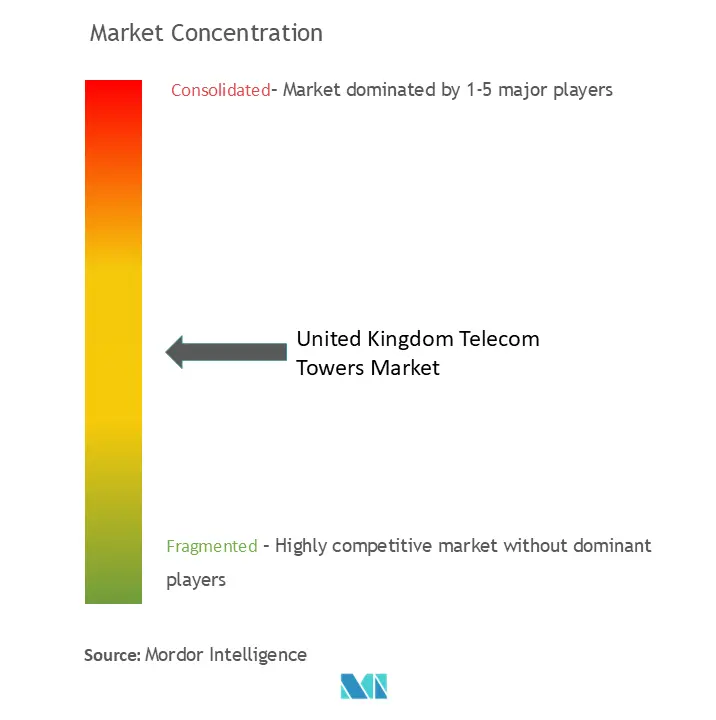
United Kingdom Telecom Towers Market News
- July 2024: Cellnex UK signed a long-term agreement with Vodafone and Virgin Media O2, supplying the two MNOs with tower infrastructure and related services. This agreement fortifies and expands the existing partnership, ensuring stability for all parties involved.
- May 2024: Virgin Media O2 and Accenture partnered to capitalize on the growing mobile private network market in the United Kingdom, projected to hit GBP 528 million (USD 673.41 million) by 2030. Accenture may enhance Virgin Media O2's 5G private network capabilities for UK businesses. Accenture specializes in helping enterprises harness the potential of 5G across various applications.
United Kingdom Telecom Towers Market Report - Table of Contents
1. INTRODUCTION
- 1.1 Study Assumptions and Market Definition
- 1.2 Scope of the Study
2. RESEARCH METHODOLOGY
3. EXECUTIVE SUMMARY
4. MARKET INSIGHTS
- 4.1 Market Overview
-
4.2 Industry Attractiveness - Porter's Five Forces Analysis
- 4.2.1 Bargaining Power of Suppliers
- 4.2.2 Bargaining Power of Buyers
- 4.2.3 Threat of New Entrants
- 4.2.4 Threat of Substitutes
- 4.2.5 Intensity of Competitive Rivalry
5. MARKET DYNAMICS
-
5.1 Market Drivers
- 5.1.1 Connecting/Improving Connectivity to Rural Areas
- 5.1.2 5G Deployment Acts as a Major Catalyst for Growth in the Cell-tower Leasing Environment
-
5.2 Market Restraints
- 5.2.1 Environmental Concerns About Power Supply Systems to Towers
- 5.2.2 Tower Sharing Between Telecom Companies
6. TECHNOLOGY SNAPSHOT
- 6.1 Technology Snapshot
7. MARKET SEGMENTATION
-
7.1 Ownership
- 7.1.1 Operator-owned
- 7.1.2 Private-owned
- 7.1.3 MNO Captive Sites
-
7.2 Installation
- 7.2.1 Rooftop
- 7.2.2 Ground-based
-
7.3 Fuel Type
- 7.3.1 Renewable
- 7.3.2 Non-renewable
8. COMPETITIVE LANDSCAPE
-
8.1 Company Profiles*
- 8.1.1 Vodafone UK
- 8.1.2 BT Group
- 8.1.3 Atlas Tower Group
- 8.1.4 Cellnex UK Ltd
- 8.1.5 Telefonica UK Limited
- 8.1.6 Crown Castle UK Limited
- 8.1.7 Virgin Media O2
- 8.1.8 Wireless Infrastructure Group
- 8.1.9 Helios Towers
- 8.1.10 Freshwave
9. INVESTMENT ANALYSIS
10. FUTURE MARKET OUTLOOK
** Subject To AvailablityUnited Kingdom Telecom Towers Industry Segmentation
Telecommunication towers encompass a variety of structures, such as monopoles, tripoles, lattice towers, guyed towers, self-supporting towers, poles, masts, and other similar forms. These towers, equipped with one or more telecommunication antennas, facilitate radio communications. They can be situated on the ground or atop a building's rooftop and often include storage for equipment and electronic components.
The UK telecom towers market is segmented by ownership (operator-owned, private-owned, and MNO captive sites), installation (rooftop and ground-based), and fuel type (renewable and non-renewable). The market size and forecasts are provided in terms of value (USD) for all the above segments.
| Ownership | Operator-owned |
| Private-owned | |
| MNO Captive Sites | |
| Installation | Rooftop |
| Ground-based | |
| Fuel Type | Renewable |
| Non-renewable |
United Kingdom Telecom Towers Market Research FAQs
How big is the United Kingdom Telecom Towers Market?
The United Kingdom Telecom Towers Market size is expected to reach 40.24 thousand units in 2024 and grow at a CAGR of 3.03% to reach 46.71 thousand units by 2029.
What is the current United Kingdom Telecom Towers Market size?
In 2024, the United Kingdom Telecom Towers Market size is expected to reach 40.24 thousand units.
Who are the key players in United Kingdom Telecom Towers Market?
Vodafone UK, BT Group, Atlas Tower Group, Cellnex UK Ltd and Telefonica UK Limited are the major companies operating in the United Kingdom Telecom Towers Market.
What years does this United Kingdom Telecom Towers Market cover, and what was the market size in 2023?
In 2023, the United Kingdom Telecom Towers Market size was estimated at 39.02 thousand units. The report covers the United Kingdom Telecom Towers Market historical market size for years: 2019, 2020, 2021, 2022 and 2023. The report also forecasts the United Kingdom Telecom Towers Market size for years: 2024, 2025, 2026, 2027, 2028 and 2029.
United Kingdom Telecom Towers Industry Report
Statistics for the 2024 United Kingdom Telecom Towers market share, size and revenue growth rate, created by Mordor Intelligence™ Industry Reports. United Kingdom Telecom Towers analysis includes a market forecast outlook for 2024 to 2029 and historical overview. Get a sample of this industry analysis as a free report PDF download.



